Accelerate > Publications
Search this online library featuring the latest FAO publications, issue papers and briefs which offer up-to-date knowledge and innovative insights for SDG acceleration.
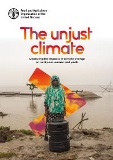
The unjust climate: Measuring the impacts of climate change on rural poor, women and youth
2024
This report assembles an impressive set of data from 24 low- and middle-income countries in five world regions to measure the effects of climate change on rural women, youths and people living in poverty. It analyses socioeconomic data collected from 109 341 rural households (representing over 950 million rural people) in these 24 countries. These data are combined in both space and time with 70 years of georeferenced data on daily precipitation and temperatures.
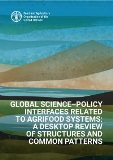
Global science–policy interfaces related to agrifood systems: a desktop review of structures and common patterns
2024
This background paper to the guidance that FAO is developing on strengthening science–policy interfaces (SPIs) for agrifood systems at the national level sets provides information about the structures and patterns common to global SPIs.
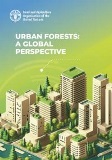
Urban forests: a global perspective
2023
Urban forestry is not a one-size-fits-all solution; each city and region, with its own unique set of challenges and opportunities, requires tailored strategies. In recognition of the diversity and distinctiveness of urban forestry issues and their potential for mitigating environmental and socioeconomic inequality across the globe, FAO has asked experts around the world to share their views on how urban forests and trees are perceived and managed in their respective geographical areas,...

Climate-related development finance to agrifood systems: Global and regional trends between 2000 and 2021
2023
This publication addresses the persistent knowledge gap related to climate finance to agrifood systems, providing data and information to support countries making informed decisions towards agrifood systems transformation. The analysis brings to light the evolution of climate finance in agrifood systems over the past two decades, showcasing unique sectorial analysis of climate finance allocations for adaptation and mitigation, delving into the diversity of actors involved...
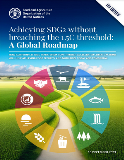
Achieving SDG2 without breaching the 1.5C threshold: A Global Roadmap
2023
Accelerated climate actions can transform agrifood systems and help achieve food security and nutrition both today and tomorrow.

FAO and the 2030 Agenda Follow-up and Review: Guidance Note for Regional and Country Offices
2023
The Guidance Note describes the process of the preparation of the VNRs and what FAO Regional and Country Offices need to be aware and mindful of when providing support to the national partners. It covers information about the importance of the follow-up and review process for the 2030 Agenda and the SDGs, including information about the gaps in the coverage of the Voluntary National Reviews, and recommendations on strengthening VNRs to be meaningful instruments for the acceleration of the SDGs.

Loss and damage and agrifood systems - Addressing gaps and challenges
2023
The purpose of this report is to stimulate discussions on the central role of agrifood systems in the loss and damage debate and identify the gaps in data, knowledge and finance that need to be addressed. The report provides an overview of the loss and damage concept, the status of analytical methodologies and tools, a summary of the reporting on loss and damage in nationally determined contributions (NDCs), an outline of the policy needs and some preliminary analysis of the financing needs.
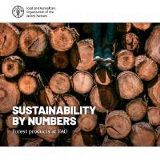
Sustainability by numbers - Forest products at FAO
2023
Over more than three-quarters of a century, FAO’s work on forest product statistics has made the Organization the recognized authority for data fundamental to what we now call the global bioeconomy. Forest product data are essential in monitoring impact and innovation in the global wood industry; responding to climate change by calculating carbon emissions; and developing equitable policies that uphold ecosystem services and forest values for our communities.
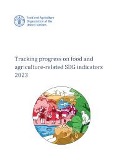
Tracking progress on food and agriculture-related SDG indicators 2023
2023
At the mid-point of the Agenda 2030 for Sustainable Development, there is an urgent need to understand where the world stands in eliminating hunger and food insecurity, as well as in ensuring sustainable agriculture. The new report of the Food and Agriculture Organization of the United Nations (FAO),offers analysis and trends on indicators across eight Sustainable Development Goals (SDGs) – in particular, SDGs 1, 2, 5, 6, 10, 12, 14 and 15.
.tmb-th600x450.jpg?Culture=en&sfvrsn=f848bd69_11)
FAO Action Plan 2022–2025 for the implementation of the FAO Strategy on Climate Change
2023
The elements of the Action Plan are derived from the Theory of Change anchored in the Strategy. The Action Plan is therefore articulated around the three pillars and six outcomes of the Strategy. In addition, and with the aim to provide more clarity, action areas have been introduced to cluster the outputs, which are concrete results contributing to each outcome of the Strategy.

The State of Food Security and Nutrition in the World 2023 - Urbanization, agrifood systems transformation and healthy diets across the rural–urban continuum
2023
This report provides an update on global progress towards the targets of ending hunger (SDG Target 2.1) and all forms of malnutrition (SDG Target 2.2) and estimates on the number of people who are unable to afford a healthy diet. Since its 2017 edition, this report has repeatedly highlighted that the intensification and interaction of conflict, climate extremes and economic slowdowns and downturns,...
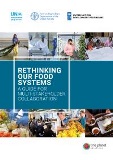
Rethinking our food systems: A guide for multi-stakeholder collaboration
2023
This guide aims to support stakeholders working at all levels of the food system in the implementation of actions to transform their food systems. Centered on 5 building blocks underpinning successful multi-stakeholder collaboration for food systems transformation, the guide uses these constructions to illustrate ingredients of the process and show the interconnectedness of the steps needed to be successful.

2023 SDG Summit: FAO Key Messages
2023
The 2023 SDG Summit will serve as a pivotal event towards achieving the SDGs, as gathered Heads of State and Government are to carry out a comprehensive review of progress, respond to the impact of multiple crises, and provide high-level political guidance on transformative and accelerated actions for achieving the 2030 Agenda. FAO has developed these key messages to inform the discussions in the lead up to and during this Summit and the Political Declaration which will result from them.
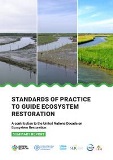
Standards of practice to guide ecosystem restoration: A contribution to the United Nations Decade on Ecosystem Restoration
2023
The United Nations Decade on Ecosystem Restoration 2021–2030 (hereafter “UN Decade”) recognizes the critical need to prevent, halt and reverse the degradation of the world’s ecosystems. Effective restoration of degraded ecosystems is of paramount importance for recovering biodiversity, ecosystem health and integrity, ecosystem goods and services, climate-change mitigation and human health and well-being.
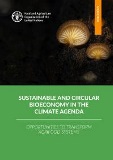
Sustainable and circular bioeconomy in the climate agenda: Opportunities to transform agrifood systems
2022
The bioeconomy offers opportunities to reduce greenhouse gas (GHG) emissions along the agrifood system by replacing fossil-based resources and processes with biological ones, from microbiome innovations, biofertilizers and biopesticides, to alternative proteins, bio-based plastics and textiles, and biological waste management, to name just a few. A sustainable and circular bioeconomy also presents opportunities to improve climate change adaptation and resilience,...

Urban and peri-urban agriculture sourcebook - From production to food systems
2022
The purpose of this book is to set out the key lessons learned and to provide recommendations and guidance based on existing cases and examples for a wide range of actors involved in urban food systems. In particular, the aim is for this publication to serve as a sourcebook for local decision-makers, policy advisors, urban planners, specialists, practitioners and others involved in urban and peri-urban agriculture (UPA).
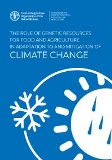
The role of genetic resources for food and agriculture in adaptation to and mitigation of climate change
2022
The main focus of this study is the state of current use of genetic resources in climate change adaptation and mitigation efforts. Each chapter explores the impacts of climate change on genetic resources and also considers the significance of genetic resources to climate change adaptation and mitigation.

Sustainable and circular bioeconomy in the biodiversity agenda - Opportunities to conserve and restore biodiversity in agrifood systems through bioeconomy practices
2022
The sustainable management of biodiversity contributes to addressing food and nutrition security, enhancing resilience, and providing livelihoods to local and indigenous communities that can diversify their activities and generate income.

Soils for nutrition: state of the art
2022
This booklet contributes to understanding processes related to soil fertility from the perspectives of food production and food security, and the environmental and climate change impacts associated with fertilizer misuse and overuse. The booklet also outlines the main areas of opportunity and the way forward to solve the nutrient imbalance prevailing in our current agrifood systems.
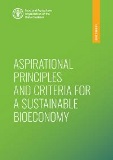
Aspirational principles and criteria for a sustainable bioeconomy
2022
To promote the production, utilization, conservation and regeneration of biological resources in ways that support global food and nutrition security and sustainable development, it is necessary to have a holistic vision for a sustainable and circular bioeconomy. Through the International Sustainable Bioeconomy Working Group (ISBWG), a multistakeholder group established in 2016,...
Browse by SDG
- SDG1: No Poverty
- SDG2: Zero Hunger
- SDG3: Good Health & Well-being
- SDG4: Quality Education
- SDG5: Gender Equality
- SDG6: Clean Water & Sanitation
- SDG7: Affordable and Clean Energy
- SDG8: Decent Work and Economic Growth
- SDG9: Industry, Innovation and Infrastructure
- SDG10: Reduced Inequalities
- SDG11: Sustainable Cities and Communities
- SDG12: Responsible Consumption and Production
- SDG13: Climate Action
- SDG14: Life Below Water
- SDG15: Life on Land
- SDG16: Peace, Justice and Strong Institutions
- SDG17: Partnerships for the Goals
Browse by Better
Browse by Priority Area
- Innovation for Sustainable Agriculture Production
- Blue Transformation
- One Health
- Small-Scale Producers' Equitable Access to Resources
- Digital Agriculture
- Healthy Diets for All
- Nutrition for the Most Vulnerable
- Safe Food for Everyone
- Reducing Food Loss and Waste
- Transparent Markets and Trade
- Climate Change Mitigating and Adapted Agrifood Systems
- Bioeconomy for Sustainable Food and Agriculture
- Biodiversity and Ecosystem Services for Food and Agriculture
- Achieving Sustainable Urban Food Systems
- Gender Equality and Rural Women's Empowerment
- Inclusive Rural Transformation
- Agriculture and Food Emergencies
- Resilient Agrifood Systems
- Hand-in-Hand Initiative
- Scaling up Investment
